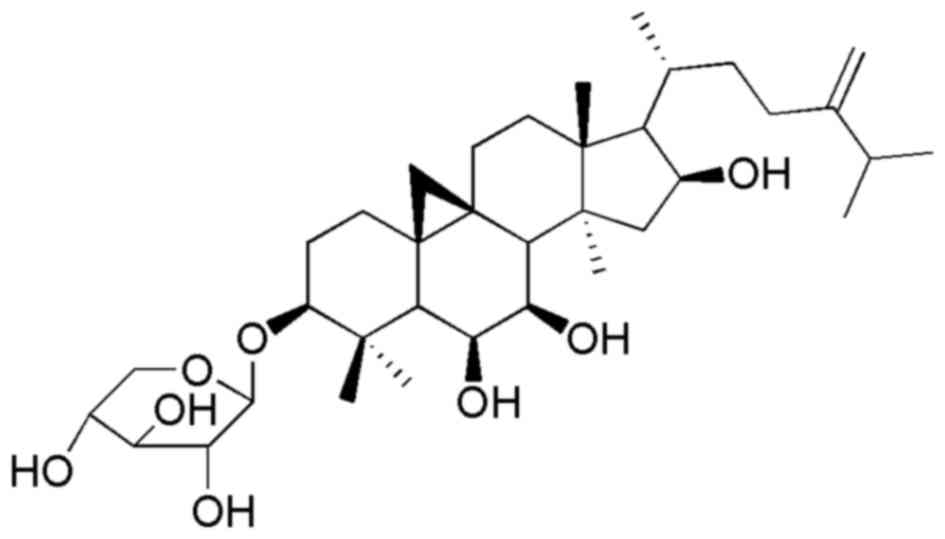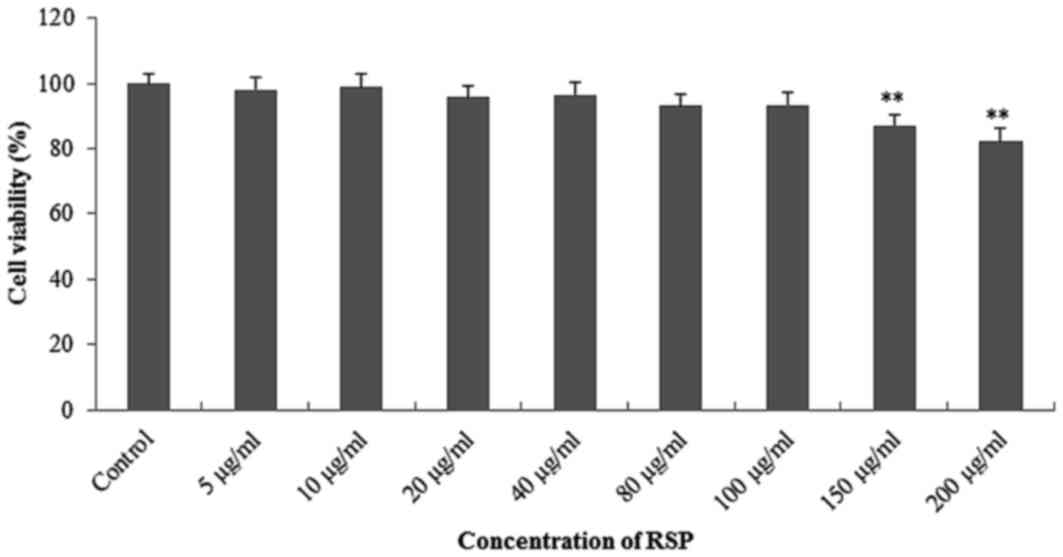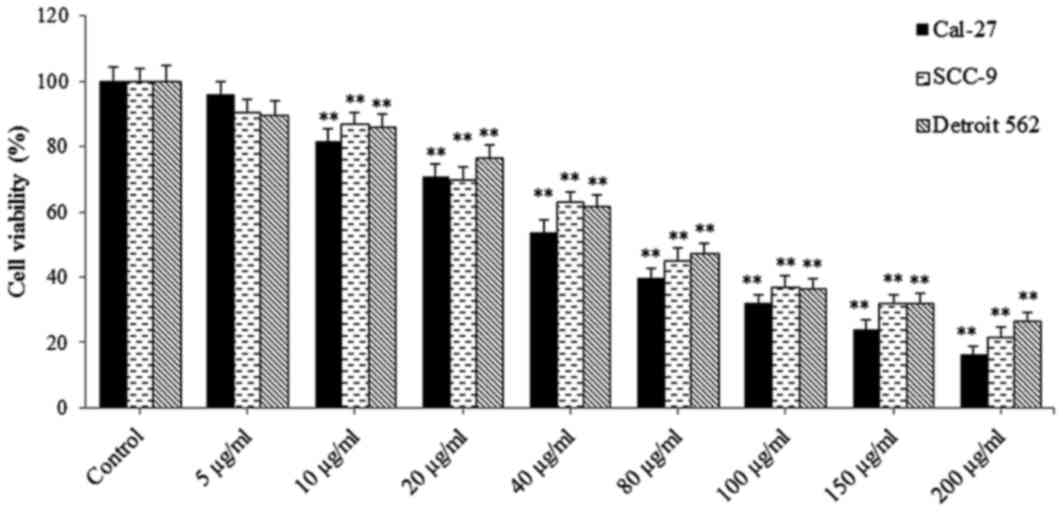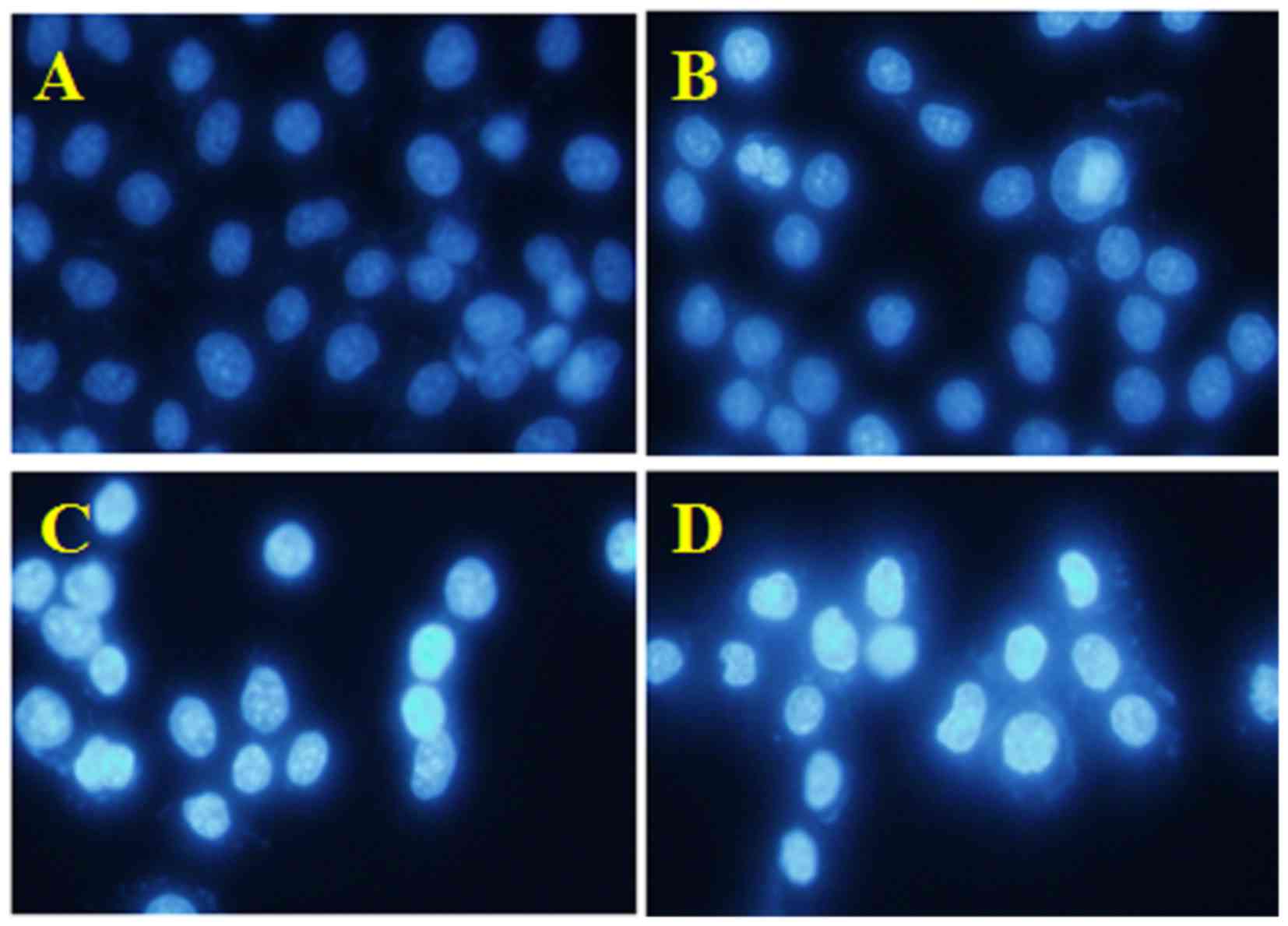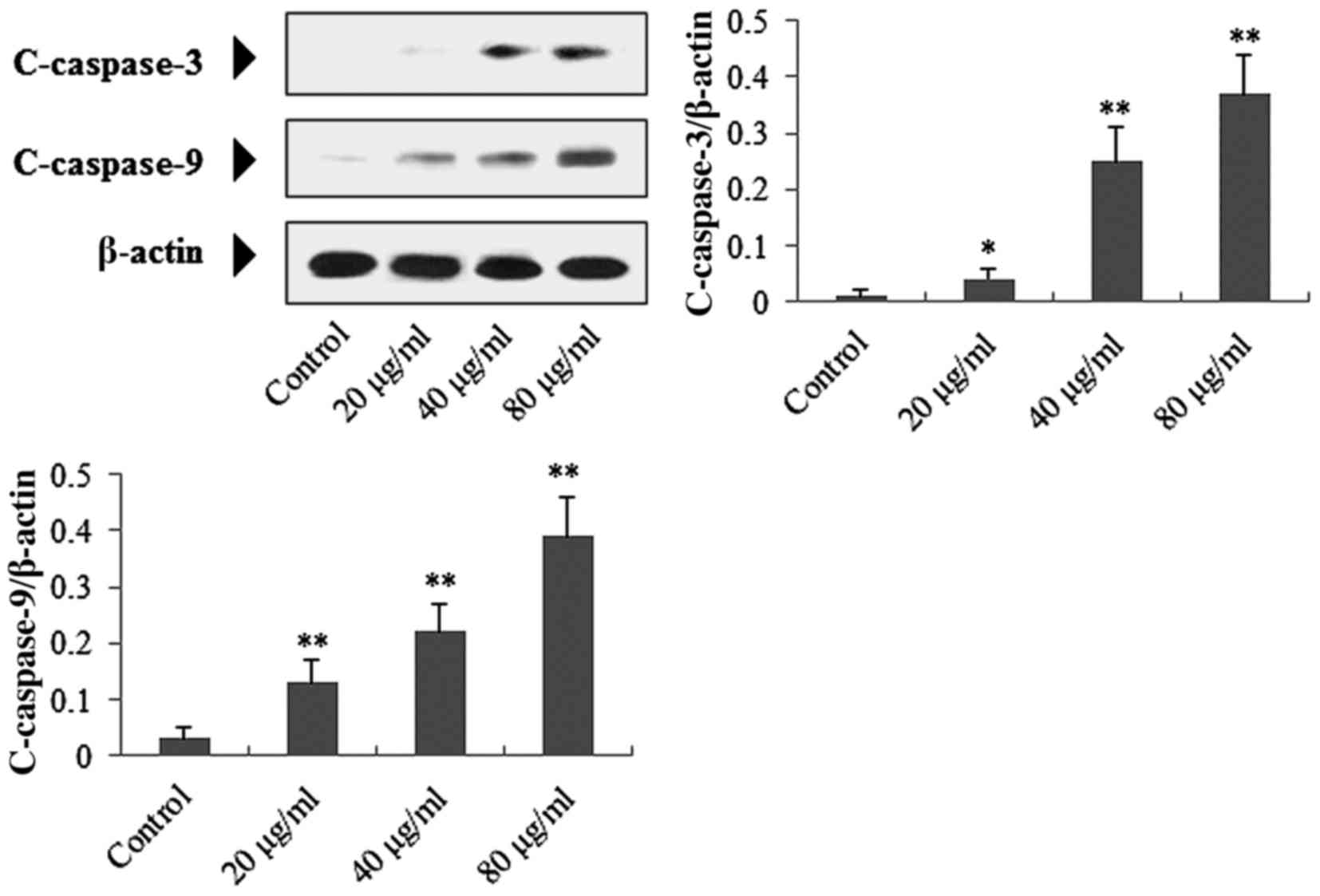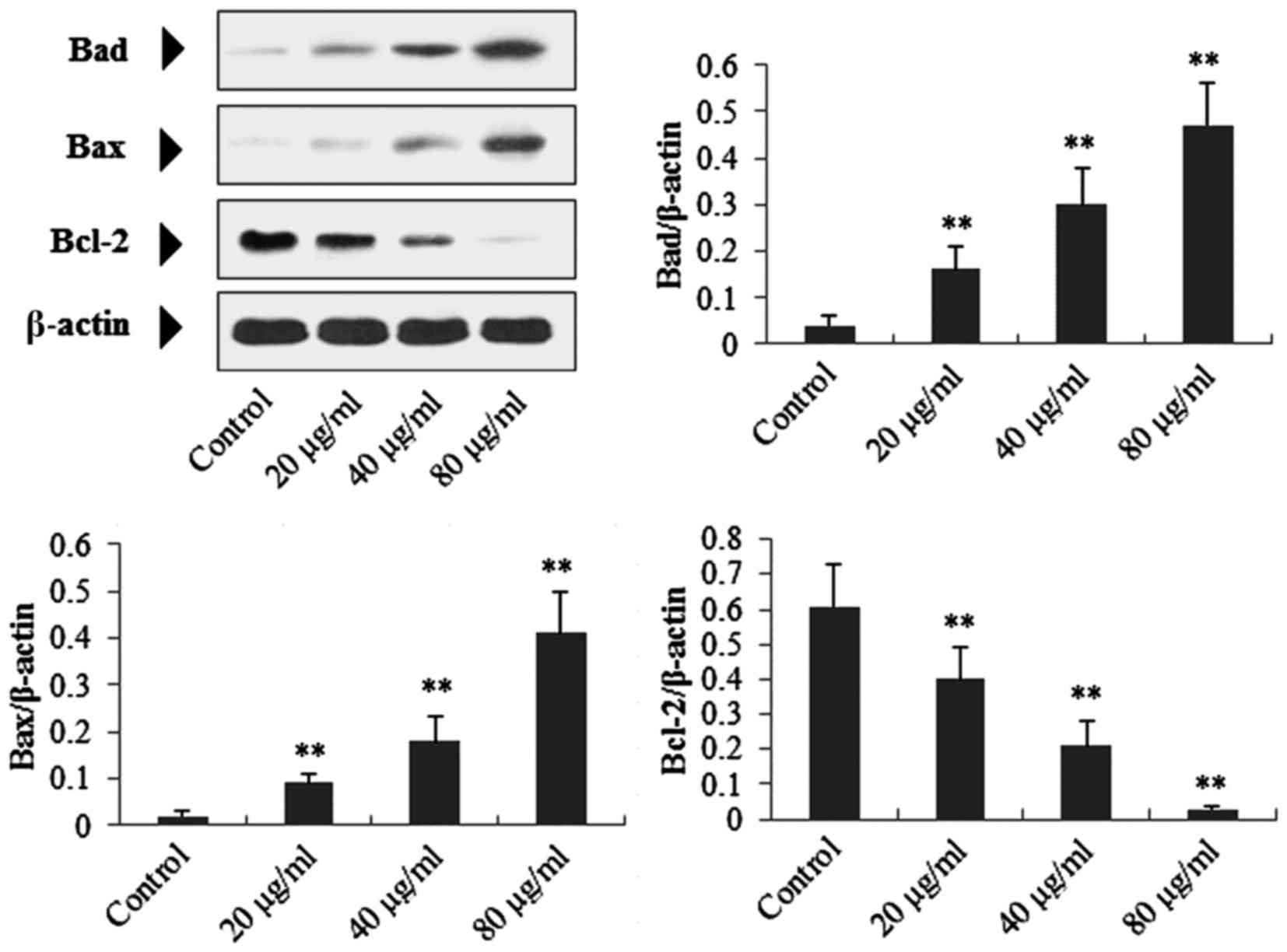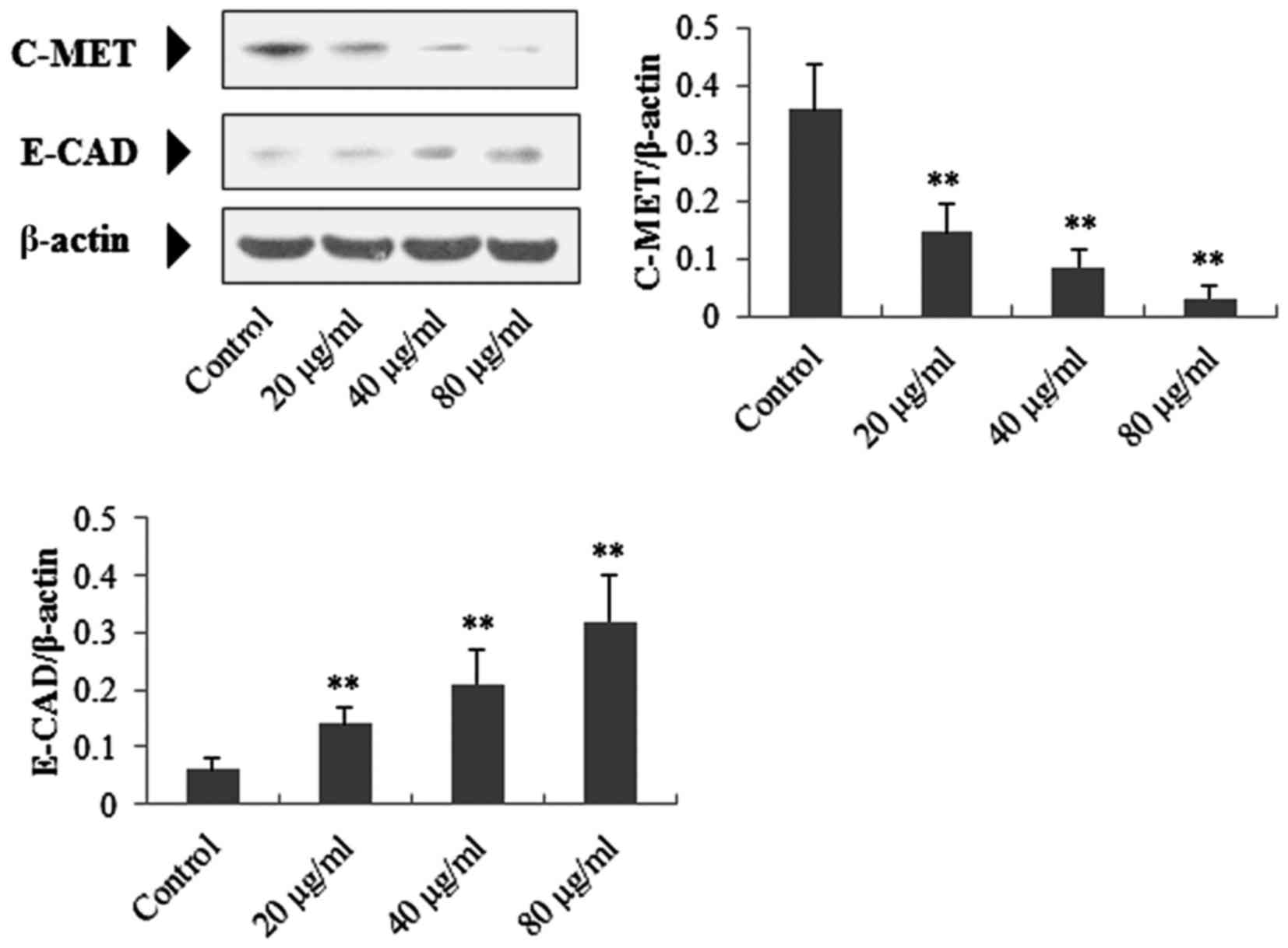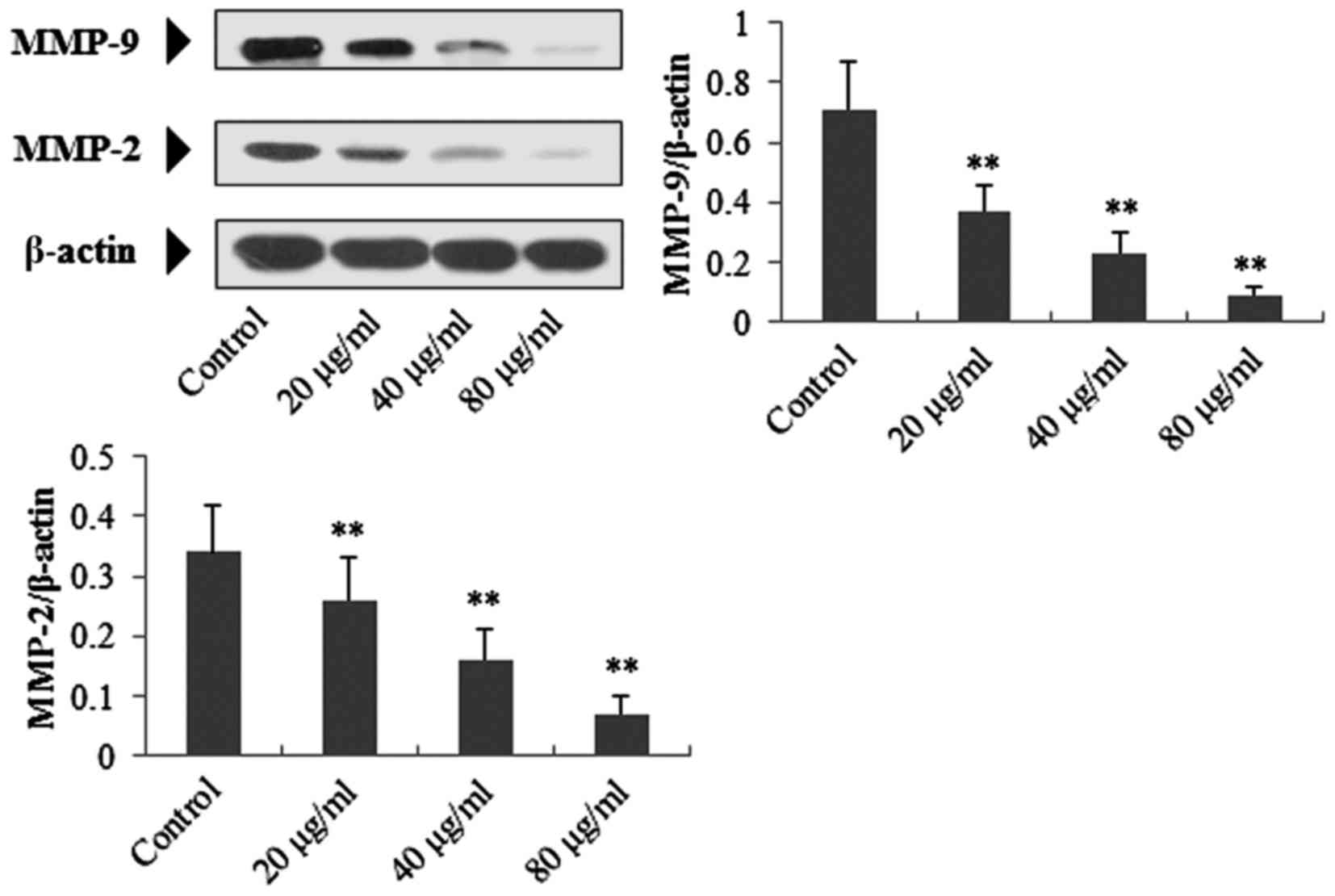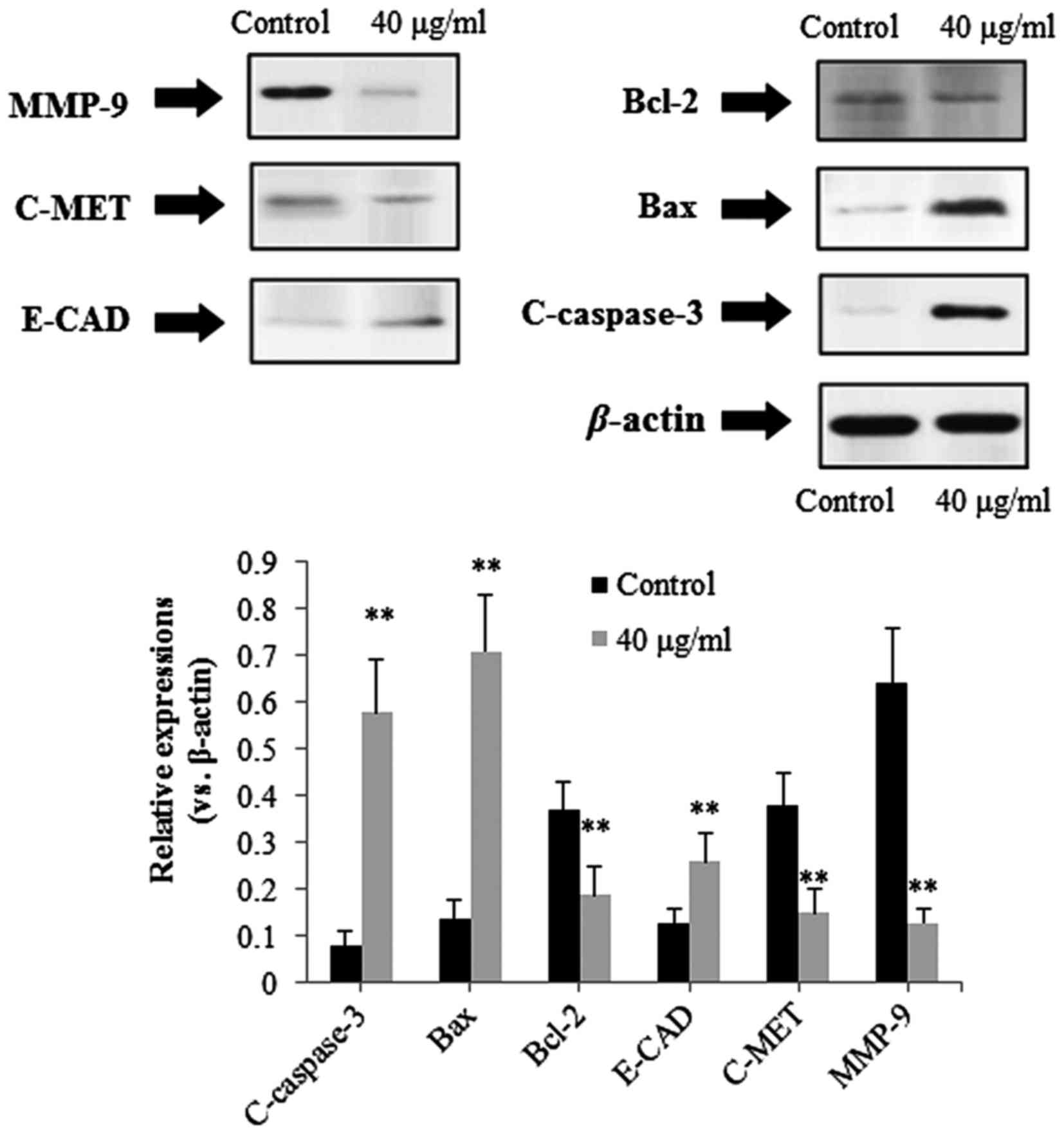Riparsaponin isolated from Homonoia riparia Lour induces apoptosis of oral cancer cells
- Authors:
- Published online on: September 25, 2017 https://doi.org/10.3892/ol.2017.7043
- Pages: 6841-6846
Abstract
Introduction
It is reported that oral squamous cell carcinoma (OSCC), one of the most common oral malignancies of the squamous epithelium of the oral cavity, is the sixth most common type of cancer globally (1–3). It has been reported that developing countries have the highest incidence rates of OSCC and it is expected that the incidence will continue to increase (4); furthermore, OSCC commonly occurs in middle-aged and elderly males because of tobacco and alcohol use (5). OSCC commonly occurs in the tissues of the oral cavity, including the gingiva, tongue, lip, hard palate, buccal mucosa and mouth floor (4,6). OSCC exhibits a marked propensity for invasive growth and metastasis, leading to damage of the original tissues or that of distant organs (2,4). The predominant treatment strategy for OSCC is radical surgery and postoperative chemoradiation (4). Marked improvements have been made in clinical diagnosis and management of OSCC; however, high recurrence rates and low 5-year survival rates have remained constant for several decades (7).
Increasingly, previous studies have revealed that chemotherapy using natural agents with low toxicity is a promising approach for treating various types of cancer (8–10). In addition, traditional Chinese medicine (TCM) has been used in the treatment of various incurable diseases for centuries, and the reliability and effectiveness of TCMs have been demonstrated by long-term clinical use in China (11,12). Homonoia riparia Lour (Euphorbiaceae), is a known source of TCM with antipyretic and detoxification functions, and is commonly used as an effective agent for treating infection, hepatitis, hemorrhoids, ulcers, tumor and ambustion (13–15). Riparsaponin (RSP; Fig. 1) is an active constituent isolated from H. riparia that possesses potential for treating gouty arthritis (16). In the present study, the antitumor effects of RSP on human oral carcinoma cells via the induction of apoptosis were systematically investigated, which has reference value for the clinical use of RSP in the treatment of OSCC.
Materials and methods
Plant materials
The roots of H. riparia were purchased from the Juhuacun Market of Traditional Chinese Herbs (Kunming, China) in October 2014, and were identified by the Department of Chinese Herbal Medicine in the Daqing Oilfield General Hospital (Daqing, China). A voucher specimen of this plant was deposited in the department of Stomatology laboratory, Daqing Oilfield General Hospital (reference no. S-hptcm-20141007).
Chemicals and reagents
Dulbecco's modified Eagle's medium (DMEM), fetal bovine serum (FBS), and anti-epithelial cadherin (E-CAD) (1:2,000; cat. no. 13-1700) and -c-MET (1:2,000; cat. no. 44-888G) antibodies were purchased from Invitrogen; Thermo Fisher Scientific, Inc. (Waltham, MA, USA). MTT, DAPI and dimethyl sulfoxide (DMSO) were purchased from Sigma-Aldrich; Merck KGaA (Darmstadt, Germany). Antibodies against cleaved caspase-3/9 (C-caspase-3/9) (1:2,000; cat. nos. 9664 and 7237, respectively), matrix metalloproteinase (MMP)-2 (1:2,000; cat. no. 87809) and MMP-9 (1:2,000; cat. no. 13667) were purchased from Cell Signaling Technology, Inc. (Danvers, MA, USA). Antibodies against B-cell lymphoma 2 (Bcl-2) (1:1,000; cat. no. AB112), Bcl-2-associated X protein (Bax) (1:1,000; cat. no. AB026), Bcl-2-associated death promoter (Bad) (1:1,000; cat. no. AB008) and β-actin (1:1,000; cat. no. AB128), goat anti-rabbit horseradish peroxidase (HRP)-conjugated secondary antibodies (1:1,000; cat. no. A0208), the enhanced chemiluminescence reagent and cell lysis buffer for Western and IP kit were purchased from Beyotime Institute of Biotechnology (Haimen, China). All other chemicals used in the present study were of analytical reagent grade.
Cell culture
Human oral carcinoma cell lines (Cal-27, SCC-9 and Detroit 562) were purchased from the American Type Culture Collection (Manassas, VA, USA), and the human embryonic lung fibroblast cell line MRC-5 was purchased from Cellcook Biotech. Co., Ltd. (Guangzhou, China). Cells were cultured in DMEM supplemented with 10% FBS, 100 U/ml penicillin and 100 µg/ml streptomycin at 37°C in a humidified incubator containing 5% CO2.
Preparation of RSP
Dried roots of H. riparia were powdered and extracted with 60% ethanol under reflux. Then, the extracts were sequentially extracted with petroleum ether, ethyl acetate and n-butanol to produce petroleum ether fraction, ethyl acetate fraction (AE), n-butanol fraction and water fraction. The AE was subjected to column chromatography (CC) over a silica gel (200–300 mesh), eluting with ethyl acetate-acetone (20:1, 15:1, 10:1, 5:1, 3:1 and 1:1) to yield four subfractions I–IV on the basis of the results of thin layer chromatography (TLC) analysis: The aforementioned CC elution samples (3 µl) were analyzed using silica gel G thin layer plate, and the chromatography was run for 8 cm using an ethyl acetate-acetone mobile phase (10:1, 5:1 and 2:1) and the TLC spots were visualized using 10% sulfuric acid alcohol chromogenic agent. Fraction III was repeatedly subjected to CC over a silica gel (200–300 mesh), eluting with ethyl acetate-acetone (15:1, 10:1, 5:1, 3:1 and 1:1) to yield four subfractions III1-III4. RSP was crystallized from III2.
The isolated RSP was identified by 1H-nuclear magnetic resonance (NMR) and 13C-NMR, and compared with results of previous studies (13,16). The 1H-NMR and 13C-NMR spectral data of this compound are as follows: 1H-NMR (500 MHz, CDCl3) δ (ppm): 0.32, 0.92 (2 H, m, H-19), 3.11 (1 H, m, H-3), 4.71 (2 H, brs, H-31), 0.84, (3 H, d, J 8.1 Hz, 21-CH3), 0.90 (3 H, s, 28-CH3), 0.93 (3 H, s, 26-CH3), 0.95 (3 H, s, 27-CH3), 1.02 (3 H, s, 29-CH3), 1.09 (3 H, s, 30-CH3), 1.17 (3 H, s, 18-CH3); 13C-NMR (125 MHz, DMSO-d6) δ (ppm): 30.97 (C-1), 29.25 (C-2), 88.97 (C-3), 42.19 (C-4), 48.91 (C-5), 71.90 (C-6), 71.04 (C-7), 46.03 (C-8), 25.14 (C-9), 18.87 (C-10), 26.99 (C-11), 33.07 (C-12), 45.81 (C-13), 45.00 (C-14), 51.03 (C-15), 71.13 (C-16), 58.31 (C-17), 21.61 (C-18), 32.04 (C-19), 28.10 (C-20), 18.04 (C-21), 37.03 (C-22), 32.82 (C-23), 160.07 (C-24), 34.21 (C-25), 22.52 (C-26), 24.01 (C-27), 20.13 (C-28), 24.82 (C-29), 16.88 (C-30), 109.27 (C-31), 105.01 (C-1′), 73.26 (C-2′), 78.38 (C-3′), 67.05 (C-4′), 68.93 (C-5′).
Determination of cell viability
Cell viability was determined using the MTT assay. Briefly, cells (1×105 cells/ml) were plated in 96-well plates for 24 h. Subsequently, cells were treated with RSP at various concentrations (0, 5, 10, 20, 40, 80, 150 and 200 µg/ml) for 24 h. Subsequently, an MTT assay was used to determine the cell viability (n=4), and the optical density value was determined at 570 nm on a microplate reader (Bio-Rad Laboratories, Inc., Hercules, CA, USA).
Nuclear staining with DAPI
A DAPI staining assay was carried out for the apoptosis assays. Briefly, cells were exposed to RSP for 24 h at 37°C, and then cells were stained with DAPI at room temperature for 5 min. Alterations in the cell nuclei were determined using fluorescence microscopy (Olympus Corporation, Tokyo, Japan) at magnification, ×200.
Western blot analysis
Following treatment with RSP (0, 20, 40 and 80 µg/ml) for 24 h at 37°C, cells were harvested and total proteins were extracted by using the Cell lysis buffer for Western and IP kit according to manufacturer's protocol. The concentration of protein was determined using a bicinchoninic acid protein assay kit. Equal amounts of protein (30 µg) were separated by SDS/PAGE (12% gel), then transferred onto a PVDF membrane and probed with various primary antibodies overnight at 4°C, followed by incubation with HRP-conjugated secondary antibodies for 1 h at room temperature. Finally, the protein bands were visualized using chemiluminescence detection with the enhanced chemiluminescence reagent. Densitometric determination of the blots was carried out using Quantity One software (version 4.0; Bio-Rad Laboratories). To normalize protein loading, antibodies against β-actin were used, and the protein level was expressed as a value relative to that of β-actin.
Statistical analysis
All data are expressed as the mean ± standard deviation, and the significance of the differences between groups was determined using one-way analysis of variance with SPSS for Windows software (version 19.0; IBM Corp., Armonk, NY, USA). P<0.05 was considered to indicate a statistically significant difference.
Results
Inhibitory effects of RSP on MRC-5 cell and oral cancer cells in vitro
For investigating the toxicological effect of RSP, the human embryonic lung fibroblast cell line MRC-5 was used. No significant cytotoxic effect of RSP on MRC-5 cells was observed at concentrations <100 µg/ml compared with the control (Fig. 2).
Furthermore, the cytotoxic effects of RSP on three human oral carcinoma cell lines (Cal-27, SCC-9 and Detroit 562 cells) were evaluated. RSP exhibited a marked anti-proliferative effect on the three oral cancer cell lines, which was concentration-dependent between 10 and 200 µg/ml (Fig. 3).
Pro-apoptotic effect of RSP on SCC-9 cells
Results of the cytotoxicity assay indicated that RSP exerts significant antitumor potential on human oral carcinoma cells. Furthermore, in order to determine whether the antitumor effect of RSP was due to apoptosis, DAPI, a widely used cell-permeant DNA dye, was used to stain SSC-9 cells for observing the nuclear morphological changes (Fig. 4). The results indicated that the cell nuclei in the control group were round and normal with faint staining (cells were alive). By contrast, following treatment with RSP at concentrations of 20, 40 and 80 µg/ml, characteristic features of apoptosis were observed, including typical nuclear condensation, increased brightness and nuclear fragmentation. These results revealed that RSP induced SSC-9 cell death due to apoptosis.
RSP upregulates C-caspase-3, C-caspase-9, Bad and Bax, and downregulates Bcl-2 in SCC-9 cells
To investigate the potential apoptotic mechanism induced by RSP in SSC-9 cells, the expression levels of associated mitochondria-mediated intrinsic apoptosis proteins were determined using western blotting. As presented in Figs. 5 and 6, following treatment with RSP (20, 40 and 80 µg/ml), expression of C-caspase-3 (P<0.05, P<0.01 and P<0.01, respectively), C-caspase-9 (P<0.01), Bad (P<0.01) and Bax (P<0.01) in SSC-9 cells were significantly increased compared with the control group, whereas Bcl-2 expression (P<0.01) was decreased.
RSP downregulates c-MET, MMP-2 and MMP-9, and upregulates E-CAD in SCC-9 cells
As presented in Figs. 7 and 8, following treatment with RSP (20, 40 and 80 µg/ml), expression levels of c-MET (P<0.01), MMP-2 (P<0.01) and MMP-9 (P<0.01) in SSC-9 cells were significantly decreased compared with the control group, whereas the expression of E-CAD (P<0.01) was increased.
Regulatory effects of RSP on the expression of C-caspase-3, Bad, Bcl-2, c-MET, E-CAD and MMP-9 in Cal-27 cells
The regulatory effects of RSP on caspase-3, Bax, Bcl-2, c-MET, E-CAD and MMP-9 in Cal-27 cells were determined. Similar to SCC-9 cells, it was identified that RSP significantly downregulated protein expression of Bcl-2 (P<0.01), c-MET (P<0.01) and MMP-9 (P<0.01), whereas protein expression of C-caspase-3 (P<0.01), Bax (P<0.01) and E-CAD (P<0.01) was upregulated (Fig. 9). These results confirmed the antitumor effects of RSP on OSCC.
Discussion
To the best of our knowledge, the present study is the first to investigate the antitumor effect of RSP on human oral carcinoma cells. Results demonstrated that RSP exhibited a notable antitumor effect against human oral carcinoma cells by inducing the intrinsic apoptosis pathway.
It has been suggested previously that uncontrolled cell proliferation and deregulation of apoptosis may be the primary reason for the occurrence of tumors (17). In addition, evidence is accumulating that apoptosis, a programmed physiological cell suicide process, is considered to be an ideal strategy for inhibiting the development and progression of cancer (18,19). Apoptosis is characterized by distinct morphological changes involving the nucleus (such as pyknosis, chromatin condensation, karyorhexis and nuclear fragmentation), the plasma membrane (phosphatidylserine exposure) and the entire cell progressively shrinks and eventually breaks into a number of ‘apoptotic bodies’. Furthermore, apoptosis is regulated by a series of biochemical events and eventually results in cell death (19,20). For apoptosis, there are two major signaling pathways including the extrinsic and the intrinsic pathway. The extrinsic apoptosis pathway is primarily mediated by ligand-bound death receptors of the tumor necrosis factor receptor family, and the intrinsic pathway, called the mitochondria-mediated apoptosis pathway, is activated primarily by mitochondria and the Bcl-2 family. However, the two apoptosis pathways ultimately activate members of the caspase family (19). The present study focused primarily on the mitochondria-mediated apoptosis induced by RSP in oral cancer cells. Caspase-9, first activated by cytochrome c in the cytoplasm, is the initiating caspase protein of the caspase cascade reaction, and the activated caspase-9 subsequently activates the executioner caspase-3. Activated caspase-3 is commonly considered to be a biomarker for cells undergoing apoptosis (19,21). Proteins in the Bcl-2 family, including Bax, Bad and Bcl-2, have been demonstrated as important members in controlling cytochrome c release in the intrinsic apoptosis pathway (22). Bax and Bad, pro-apoptotic Bcl-2 family members, promote the release of cytochrome c into the cytosol (19,21). In contrast, Bcl-2 is the anti-apoptotic protein that prevents the release of cytochrome c by preserving mitochondrial integrity (19,20). The results of the present study revealed that RSP upregulates C-caspase-3, C-caspase-9, Bad and Bax, and downregulates Bcl-2, leading to mitochondria-mediated apoptosis.
Increasingly, previous research has indicated that metastasis is a primary reason for the recurrence and mortality of patients with OSCC. The process of metastasis is regulated by a variety of genes, such as E-CAD, c-MET, MMP-2 and MMP-9. E-CAD, a membranous glycoprotein, exerts important effects in the maintenance of cell-cell adhesion, epithelial tissue polarity preservation and structural integrity (23–25). Epidemiological studies have identified that the expression of E-CAD is commonly downregulated in OSCC, thus decreased E-CAD levels may be considered an indicator of unfavorable prognosis in OSCC (24). c-MET, a transmembrane tyrosine kinase receptor is commonly recognized as a crucial factor for mediating the oncogenic activities of hepatocyte growth factor. Upregulation of c-MET has been reported to contribute to the progression and dissemination of various malignancies (26). MMPs, a family of zinc-dependent proteinases, are able to degrade the majority of the extracellular matrix components (27,28). In the development of malignancies, activated MMPs may promote the degradation of extracellular matrix, movement of tumor cells and tumor growth, which are directly associated with invasion, metastasis and poor prognosis of malignancies. Previous studies have demonstrated that MMP-2 and MMP-9 are commonly upregulated in various types of malignant tissues (2,29,30). Results of the present study revealed that RSP downregulates E-MET, MMP-2 and MMP-9, whereas RSP upregulates E-CAD, indicating that RSP exhibits inhibitory potential on the metastasis of OSCC.
The results of the present study demonstrated that RSP exhibited significant antitumor activity against OSCC via inducing mitochondria-mediated apoptosis.
References
|
Huang HZ and Wang C: Molecular mechanisms of invasion-metastasis cascade in oral cancer. J Oral Maxil Surg. 20:77–82. 2011. | |
|
Kaomongkolgit R, Cheepsunthorn P, Pavasant P and Sanchavanakit N: Iron increases MMP-9 expression through activation of AP-1 via ERK/Akt pathway in human head and neck squamous carcinoma cells. Oral Oncol. 44:587–594. 2008. View Article : Google Scholar : PubMed/NCBI | |
|
Siegel R, Naishadham D and Jemal A: Cancer statistics, 2012. CA Cancer J Clin. 62:10–29. 2012. View Article : Google Scholar : PubMed/NCBI | |
|
Malik UU, Zarina S and Pennington SR: Oral squamous cell carcinoma: Key clinical questions, biomarker discovery, and the role of proteomics. Arch Oral Biol. 63:53–65. 2016. View Article : Google Scholar : PubMed/NCBI | |
|
Acharya S, Rai P, Hallikeri K, Anehosur V and Kale J: Serum lipid profile in oral squamous cell carcinoma: Alterations and association with some clinicopathological parameters and tobacco use. Int J Oral Maxillofac Surg. 45:713–720. 2016. View Article : Google Scholar : PubMed/NCBI | |
|
Abe S, Oikawa M, Miki Y, Shimizu Y, Suzuki T, Takahashi T and Kumamoto H: Immunohistochemical and genetic evaluations of epidermal growth factor receptor (EGFR) in oral squamous cell carcinoma. J Oral Maxillofac Surg Med Pathol. 28:174–181. 2016. View Article : Google Scholar | |
|
Gohulkumar M, Gurushankar K, Prasad N Rajendra and Krishnakumar N: Enhanced cytotoxicity and apoptosis-induced anticancer effect of silibinin-loaded nanoparticles in oral carcinoma (KB) cells. Mater Sci Eng C Mater Biol Appl. 41:274–282. 2014. View Article : Google Scholar : PubMed/NCBI | |
|
Chen L, Zeng R and Zhuang Y: In vitro anti-gastric tumor activities and possible mechanisms of action of paederosidic acid from Paederia scandens (Lour) Merrill. Trop J Pharm Res. 14:795–800. 2015. View Article : Google Scholar | |
|
Kinghorn AD, Chin YW and Swanson SM: Discovery of natural product anticancer agents from biodiverse organisms. Curr Opin Drug Discov Devel. 12:189–196. 2009.PubMed/NCBI | |
|
Peng W, Hu C, Shu Z, Han T, Qin L and Zheng C: Antitumor activity of tatariside F isolated from roots of Fagopyrum tataricum (L.) Gaertn against H22 hepatocellular carcinoma via up-regulation of p53. Phytomedicine. 22:730–736. 2015. View Article : Google Scholar : PubMed/NCBI | |
|
Liu P, Yang H, Long F, Hao HP, Xu X, Liu Y, Shi XW, Zhang DD, Zheng HC, Wen QY, et al: Bioactive equivalence of combinatorial components identified in screening of an herbal medicine. Pharm Res. 31:1788–1800. 2014. View Article : Google Scholar : PubMed/NCBI | |
|
Wu WY, Hou JJ, Long HL, Yang WZ, Liang J and Guo DA: TCM-based new drug discovery and development in China. Chin J Nat Med. 12:241–250. 2014.PubMed/NCBI | |
|
Lee I, Kim J, Kim YS, Yoo NH, Kim CS, Jo K, Kim JH, Bach TT and Kim JS: Cycloartane-type triterpenes from the leaves of Homonoia Riparia with VEGF-induced angiogenesis inhibitor activity. J Nat Prod. 75:1312–1318. 2012. View Article : Google Scholar : PubMed/NCBI | |
|
State Administration of Traditional Chinese Medicine. Chinese Material Medica; Science and Technology Press of Shanghai: Shanghai, China. 6:824–825. 1999. | |
|
Viswanadh GS, Ramaiah PA, Laatsch H and Maskey R: Chemical constituents of the heartwood and bark of Homonoia riparia. J Trop Med Plants. 7:267–273. 2006. | |
|
Xu F, Zhao X, Yang L, Wang X and Zhao J: A new cycloartane-type triterpenoid saponin xanthine oxidase inhibitor from Homonoia riparia Lour. Molecules. 19:13422–13431. 2014. View Article : Google Scholar | |
|
Qi F, Li A, Zhao L, Xu H, Inagaki Y, Wang D, Cui X, Gao B, Kokudo N, Nakata M and Tang W: Cinobufacini, an aqueous extract from Bufo bufo gargarizans Cantor, induces apoptosis through a mitochondria-mediated pathway in human hepatocellular carcinoma cells. J Ethnopharmacol. 128:654–661. 2010. View Article : Google Scholar | |
|
Kerr JF, Winterford CM and Harnon BV: Apoptosis. Its significance in cancer and cancer therapy. Cancer. 73:2013–2026. 1994. View Article : Google Scholar | |
|
Wang X: The expanding role of mitochondria in apoptosis. Genes Dev. 15:2922–2933. 2001. | |
|
Galluzzi L, Zamzami N, de La Motte Rouge T, Lemaire C, Brenner C and Kroemer G: Methods for the assessment of mitochondrial membrane permeabilization in apoptosis. Apoptosis. 12:803–813. 2007. View Article : Google Scholar | |
|
Shi YG: A structural view of mitochondria-mediated apoptosis. Nat Struct Biol. 8:394–401. 2011. View Article : Google Scholar | |
|
Chipuk JE, McStay GP, Bharti A, Kuwana T, Clarke CJ, Siskind LJ, Obeid LM and Green DR: Sphingolipid metabolism cooperates with BAK and BAX to promote the mitochondrial pathway of apoptosis. Cell. 148:988–1000. 2012. View Article : Google Scholar | |
|
Beavon IR: The E-cadherin-catenin complex in tumour metastasis: Structure, function and regulation. Eur J Cancer. 36:1607–1620. 2000. View Article : Google Scholar | |
|
Martínez A, Spencer ML, Borlando J, Flores M and Rojas IG: E-cadherin and c-Met expression in actinic cheilits and lip squamous cell carcinoma. Rev Clin Periodoncia Implantol Rehabil Oral. 4:122–125. 2011. View Article : Google Scholar | |
|
Yang XK, Yang YD, Tang SQ, Xu L, Yang GH, Xu QY, Tang H and Wu JJ: Inhibitory effect of polysaccharides from Scutellaria barbata D. Don on invasion and metastasis of 95-D cells lines via regulation of C-MET and E-CAD expressions. Trop J Pharm Res. 12:517–522. 2013. | |
|
Yang L, Liu M, Deng C, Gu Z and Gao Y: Expression of transforming growth factor-β1 (TGF-β1) and E-cadherin in glioma. Tumour Biol. 33:1477–1484. 2012. View Article : Google Scholar | |
|
Qin Y, Ye GX, Wu CJ, Wang S, Pan DB, Jiang JY, Fu J and Xu SQ: Effect of DAPK1 gene on proliferation, migration, and invasion of carcinoma of pancreas BxPC-3 cell line. Int J Clin Exp Pathol. 7:7536–7544. 2014. | |
|
Sanchavanakit N, Saengtong W, Manokawinchoke J and Pavasant P: TNF-α stimulates MMP-3 production via PGE2 signalling through the NF-κB and p38 MAPK pathway in a murine cementoblast cell line. Arch Oral Biol. 60:1066–1074. 2015. View Article : Google Scholar | |
|
Duxbury MS and Whang EE: RRM2 induces NF-kappaB-dependent MMP-9 activation and enhances cellular invasiveness. Biochem Biophys Res Commun. 354:190–196. 2007. View Article : Google Scholar | |
|
Silva EJ, Argyris PP, Zou XQ, Ross KF and Herzberg MC: S100A8/A9 regulates MMP-2 expression and invasion and migration by carcinoma cells. Int J Biochem Cell Biol. 55:279–287. 2014. View Article : Google Scholar |



